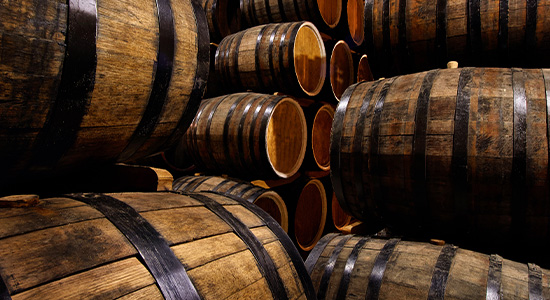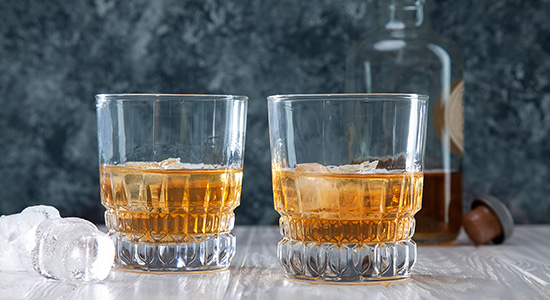
When it comes to spirits, bourbon and whiskey are two beloved classics that have captured the hearts of enthusiasts worldwide. Though there are many similarities between these beverages, there are distinct differences that set them apart. In today’s blog, we’ll delve into the world of bourbon and whiskey, uncovering their unique characteristics, origins, and more.
Let’s start by clarifying one common misconception: all bourbon is whiskey, but not all whiskey is bourbon.
Ingredients and Distillation Process
The key differences in the production process between bourbon and other types of whiskey, such as Scotch or Irish whiskey, are primarily related to the ingredients, aging process, and location. Here are the key distinctions:
1. Mash Bill:
- Bourbon: The primary grain used in bourbon must be corn, and the mash bill must contain at least 51% corn. The remaining grains can include malted barley, rye, and wheat.
- Other Whiskey Types: Other whiskeys, like Scotch and Irish whiskey, may use different combinations of grains, such as barley, malted barley, rye, and wheat, but they are not required to use corn as the primary grain.
2. Location:
- Bourbon: By law, bourbon must be produced in the United States. Kentucky is particularly famous for its bourbon production, but it can be made anywhere in the U.S.
- Whiskey: Scotch whisky must be made in Scotland, Irish whiskey in Ireland, and so on. Each region’s production methods and regulations are specific to their respective types of whiskey.
3. Aging Requirements:
- Bourbon: To be called “straight bourbon,” the spirit must be aged in new charred oak barrels. There is no specific aging duration required by law, but to be labeled as “straight,” it must be aged for at least two years. Bourbon often has a rich, caramel, and vanilla flavor due to the new oak barrels.
- Other Whiskey Types: The aging requirements for other whiskey types vary. Scotch whisky, for example, must be aged for a minimum of three years in oak barrels, and the type of oak used can differ. Scotch often has a wide range of flavor profiles, from peaty and smoky to fruity and floral.
4. Distillation Proof:
- Bourbon: Bourbon is typically distilled to no more than 160 proof (80% alcohol by volume) and enters the barrel for aging at no more than 125 proof.
- Other Whiskey Types: The distillation proof can vary for other whiskey types, depending on the region and the distillery’s practices.
5. Flavor Profile:
- Bourbon: Due to its high corn content, bourbon often has a sweeter, fuller-bodied flavor with notes of caramel, vanilla, and oak.
- Other Whiskey Types: Other whiskeys may have different flavor profiles based on their grain composition and regional characteristics. Scotch whisky, for example, can range from light and floral to peaty and smoky.
These differences in production processes result in distinct flavor profiles and characteristics for each type of whiskey, making bourbon uniquely American and separate from other whiskey styles.

Age Matters: Bourbon and Whiskey Aging
Both bourbon and whiskey benefit from aging in oak barrels, but the aging process can vary significantly depending on the type and region. Here’s a brief overview of how aging affects these spirits:
Bourbon Aging:
- Bourbon aging typically takes place in new charred oak barrels, and the duration can vary widely. To be labeled as “straight bourbon,” it must be aged for at least two years.
- Longer aging periods in bourbon can mellow the spirit, rounding out the harsher edges and allowing the flavors to integrate more smoothly.
Whiskey Aging:
- Scotch whisky must be aged for a minimum of three years in oak barrels, although many Scotch whiskies are aged for much longer.
- The aging process in whisky can lead to a wide range of flavors and complexities. For example, longer aging can result in more pronounced oak and sherry influences in Scotch whisky.

Geographical Origins
Bourbon’s heartland is unquestionably Kentucky, with the state being internationally recognized as the bourbon capital of the world. The region’s limestone-filtered water and climate contribute to the distinctive taste of bourbon.
Whiskey hails from diverse regions worldwide. Scotch whiskey, famous for its smoky and peaty notes, originates in Scotland. Irish whiskey is known for its smoothness and can be found on the Emerald Isle. American whiskey spans Kentucky, Tennessee, and beyond, each with its unique characteristics influenced by geography and climate.
Location and climate play significant roles in shaping the flavor profiles of bourbon and whiskey. The environmental conditions in which these spirits are produced can influence how they age in barrels and the final taste characteristics. Here’s how location and climate impact the flavor profiles of bourbon and whiskey:
In regions with hot climates, such as parts of the southern United States, the temperature fluctuates significantly throughout the year. This causes the whiskey to expand into the wood of the barrel during hot periods, absorbing flavors from the charred oak. During colder periods, it contracts, pushing the whiskey back out of the wood, carrying additional flavors. This “breathing” process intensifies the interaction between the spirit and the wood, resulting in a faster maturation process and richer, more complex flavors. You often find bourbon from these regions to have more pronounced oak, caramel, and vanilla notes.
In cooler regions like Scotland, Ireland, or parts of Canada, temperature fluctuations are less extreme. This slower interaction with the wood can result in a more delicate and subtle extraction of flavors. Scotch whisky, for example, often has a lighter, fruitier, and more floral character.
Legal Definitions and Regulations
Bourbon has strict legal definitions and regulations. To be labeled as bourbon in the United States, a spirit must meet specific criteria, including being made from a grain mixture that’s at least 51% corn, distilled to no more than 160 proof, and aged in new charred oak barrels.
Other whiskey varieties, such as Scotch and Irish whiskey, have their own sets of regulations that govern production, including aging requirements and labeling standards.

Flavor Profiles
Bourbon
Bourbon is often characterized by its sweet, rich, and full-bodied flavor profile. Notes of caramel, vanilla, and oak are common, with variations arising from the mash bill and aging process.
Whiskey
The flavor profiles of whiskey can vary dramatically depending on the type and region. Scotch whiskey can offer smoky, peaty, and fruity notes, while Irish whiskey is typically smoother with hints of honey and fruit. American whiskeys can range from sweet and mellow to robust and spicy.
Whether you’re sipping a smooth Irish whiskey or indulging in the rich, caramel notes of a Kentucky bourbon, the world of spirits offers something for every palate. So, the next time you raise a glass, take a moment to appreciate the subtle, yet distinctive, differences that make bourbon and whiskey two of the most cherished spirits in the world.
Here Are a Few Popular Bourbons & Whiskeys
Copyright 2023 Spec’s Wines, Spirits & Finer Foods. All rights reserved. This material may not be published, broadcast, rewritten, or redistributed.




